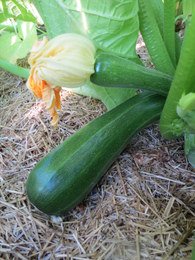Zucchini Growing Guide
Zucchini (Cucurbita pepo) is a summer squash that is a favorite with vegetable gardeners. It puts out vines that grow quickly and can reward you with a large harvest continuously during the warm summer months. It is harvested while in the immature stage of growth, when the skin is soft and the seeds are very small and soft.
Soil Preparation
The soil should be nice loose well drained organic garden soil with the soil pH between 5.8 to 6.8. As soon as the soil is frost-free and can be worked, till the soil by digging down 8 to 12-inches turning the soil over with a garden fork. Remove any large rocks and stones. The small stones remaining will do no harm and actually benefit the soil by adding some micro-nutrients to the soil.
Planting
Plant zucchini in full sun directly in the garden after all danger of frost. Sow several seeds 1-inch deep around a 12-inch hill. After the seeds germinate thin to 3-seeds per hill.
Water the vines deeply once a week to keep the shallow roots from drying out, in particular, when the plants are flowering.
If you do not have much space you can choose a bush variety. There are many varieties that can be grown in containers.
To lessen the chance of getting vine borers, plant later in the season. Waiting 4 to 6-weeks after the last frost date to plant can be very helpful.
For more detailed information visit the seed starting page.
Watering and Care
When the zucchini plants are a few inches tall a nice loose mulch of shredded leaves or pine straw will help shade the roots. This will keep the weeds out, the soil cooler and from drying out.
Zucchini are shallow rooted and should be deeply watered once a week. Keep water off of the leaves to prevent disease.
Harvesting Zucchini
It is best to pick Zucchini when it is 6 to 8-inches long and up to 2-inches in diameter. This encourages the plant to produce more and at this stage it is at its flavorful best. Use a sharp knife or pruning shears leaving a stem about an inch long.
Check your plants every other day and remove those that are 6 to 8-inches long. Those that escaped detection and grew too long can be cut up and added to the compost pile. One that is the size of a baseball bat is way past its prime. The inside will be soft and spongy with hard seeds.
Zucchini bread is a summer favorite as well as adding to pancakes and casseroles to use up the excess. Use some creativity in preparing your meals and if you still have too much, your friends and neighbors will appreciate a few.
You can keep it in the refrigerator for about a week, but it does not store well after that. Other ways to preserve your harvest are freezing, pickling and drying.
Popular Varieties
Bush: Bush Baby, Patio Star, Raven, Summer Green Tiger.
Vine: Black Beauty, Black Hawk, Fordhook, Partenon Hybrid, Richgreen Hybrid.
Sources: Seeds Now, Burpee, Johnny’s Selected Seeds
Diseases and Pests
Downy mildew and powdery mildew are common in some areas. Choosing resistant varieties and maintaining good air circulation around the plant are the best ways to avoid any problems. Remove any diseased leaves and put in the trash, not in the compost pile.
There are several squash vine borers that can cause problems. Examine your vines often near where it comes out of the ground. Look for a small entry hole and what looks like sawdust. To save the plant you need to remove the 1-inch long caterpillar.
To do this make a lengthwise slit near the entry hole and spread the sides of the slit to reveal the caterpillar. Use tweezers to carefully remove it, doing as little damage to the vine as possible. Now pile some soil over the slit to encourage the growth of new roots there. Cover with mulch and water when needed.
Cucumber beetles and squash bugs are common pest problems. Sticky traps and hand picking are used by many gardeners as well as some organic sprays. Examine your squash plants often, especially on the bottom of the leaves where the adults hide and lay their eggs.
Duct tape is a very effective way to remove the adults and eggs. Take a piece about 8 or 9-inches long and attach the ends together to form a loop with the sticky side out. Put one hand through the loop and with the other lift up a leaf looking for any eggs or adults. If you find any adults stick them to the tape and do the same for the eggs.
Tips and Warnings
At the end of the growing season, carefully pull up the vines and put in the trash, not the compost pile. The vines may contain eggs or larvae, that may be hiding on the leaves or inside the stems.
Garden Spikes newsletters give you timely information once or twice a month. Subscribe Free to the Garden Times newsletter below.
Your email address will only be used to send you a newsletter and will never be sold. You can unsubscribe at any time.

